A Multi-Criteria Decision-Making Approach for Assessing the Sustainability of an Innovative Pin-Connected Structural System
Abstract
1. Introduction
2. Literature Reviews
2.1. Structural System Sustainability Assessment
2.2. Sustainable Criteria for Structural System Selection
2.3. MCDA Approaches
3. Materials and Methods
3.1. Evaluation Framework
3.2. Fuzzy AHP Method
4. Sustainability Assessment to Select the Structural System
4.1. Structural Systems (Alternatives) Description
4.2. Fuzzy AHP Application
5. Results
Sensitivity Analysis
- (1)
- Changes to the weight of the criteria.
- (2)
- Changes to the measurement scale.
- (3)
- Different criteria formulations are identified.
6. Conclusions
- The framework empowers structural engineers to evaluate and select the most efficient system by considering various decision-making factors.
- The MCDA approach’s validity was confirmed through practical applications, demonstrating its effectiveness as a tool for developing new structural systems.
- The proposed model (the hierarchical tree) is flexible, allowing users to modify it without restricting alternatives.
- This research offers significant benefits for engineers and society by enhancing the potential of structural design to minimize its negative impacts.
Author Contributions
Funding
Data Availability Statement
Acknowledgments
Conflicts of Interest
Appendix A
| Expert’s Opinion | Strongly Disagree SD | Disagree D | Neutral N | Agree A | Strongly Agree SA |
| A.1 CO2 emission |  |  |  |  |  |
| A.2 Energy efficiency |  |  |  |  |  |
| A.3 Land use |  |  |  |  |  |
| A.4 Abiotic depletion potential |  |  |  |  |  |
| A.5 Acidification potential |  |  |  |  |  |
| A.6 Eutrophication potential |  |  |  |  |  |
| B.1 Revenue generation |  |  |  |  |  |
| B.2 Total cost |  |  |  |  |  |
| B.3 Landfill-cost savings |  |  |  |  |  |
| C.1 Job creation |  |  |  |  |  |
| C.2 Noise emission |  |  |  |  |  |
| C.3 Human toxicity |  |  |  |  |  |
| C.4 Health and Safety |  |  |  |  |  |
| C.5 Social Commitment |  |  |  |  |  |
| C.6 Information Disclosure |  |  |  |  |  |
Appendix B
- Sample of the Questionnaire
- Dear respondent,
- The following questionnaire is crafted to explore the selection criteria for contractors. Your input will aid us in determining the significance of various factors such as “good records,” “financial capabilities,” “planning and project control abilities,” and “technical expertise” in the contractor selection process. Additionally, your insights will help establish the relative weights of relevant sub-criteria associated with these main criteria. Your participation is invaluable to this research, and your time and contribution are greatly appreciated.
- In this study, the comparative values of criteria and sub-criteria are denoted by options A to E for relative assessment.
- A: Very more important
- B: More important
- C: Equally important
- D: Less important
- E: Very less important
- The following questions assess the comparative importance of specific criteria in the selection of contractors.: “environmental”, “social”, and “economic”.
- Please indicate the relative importance of each criterion by checking the appropriate boxes:
- 1.
- How important is the criterion of “environmental” as compared with the criterion of “social”?
- 2.
- How important is the criterion of “environmental” as compared with the criterion of “economic”?
- 3.
- How important is the criterion of “economic” as compared with the criterion of “social”?
- The following questions compare with each other the importance of the following sub-criteria relating to the criterion of “Construction, Maintenance, Management, CO2 emission, Energy consumption, Waste, Noise, Aesthetic, Safety”.
- Please indicate the relative importance of sub-criteria by checking the appropriate boxes.
- 4.
- How important is the criterion of “Construction” as compared with the criterion of “Maintenance”?
- 5.
- How important is the criterion of “Maintenance” as compared with the criterion of “Management”?
- 6.
- How important is the criterion of “Construction” as compared with the criterion of “Management”?
- 7.
- How important is the criterion of “CO2 emission” as compared with the criterion of “Energy consumption”?
- 8.
- How important is the criterion of “CO2 emission” as compared with the criterion of “Waste”?
- 9.
- How important is the criterion of “Energy consumption” as compared with the criterion of “Waste”?
- 10.
- How important is the criterion of “Noise” as compared with the criterion of “Aesthetic”?
- 11.
- How important is the criterion of “Safety” as compared with the criterion of “Aesthetic”?
- 12.
- How important is the criterion of “Safety” as compared with the criterion of “Noise”?
- Perhaps the questions in this questionnaire are limiting your ability to fully express your thoughts on the selection criteria for contractors. If that’s the situation, please feel free to share your views in the provided space below.
- Personal data:
- Name: Surname:
- Place of service: Organizational position:
- Work record:
- Date when the questionnaire was filled out:
- Your highest educational degree:
- High school diploma □ Associate’s degree □
- Bachelor’s degree □ Master’s or a higher degree □
- Lower □
- In which one of the following fields do you have experiences?
- Technical and commercial committee □ Contract affairs □
- Project execution □ Practices of contractors □
- How long did you work in the above fields?
- Less than a year □ One to three years □
- More than three years □
- Thank you for your honest cooperation. Please review the questionnaire again to ensure that no questions were overlooked, and then kindly return
References
- Hamilton, J.; Kennard, D.H.; Rapf, O.; Kockat, D.J.; Zuhaib, D.S.; Toth, D.Z.; Barrett, M.; Milne, C. Global Status Report for Buildings and Construction: Towards a Zero-Emission, Efficient and Resilient Buildings and Construction Sector; United Nations Environment Programme; United Nations: Nairobi, Kenya, 2022; ISBN 978-92-807-3984-8. [Google Scholar]
- Rebelatto, B.G.; Salvia, A.L.; Brandli, L.L.; Leal Filho, W. Examining Energy Efficiency Practices in Office Buildings through the Lens of LEED, BREEAM, and DGNB Certifications. Sustainability 2024, 16, 4345. [Google Scholar] [CrossRef]
- SE 2050 Challenge. Available online: https://carbonleadershipforum.org/se-2050-challenge/ (accessed on 10 May 2023).
- Khoshnava, S.M.; Rostami, R. Rank of green building material criteria based on the three pillars of sustainability using the hybrid multi criteria decision making method. J. Clean. Prod. 2018, 173, 82–99. [Google Scholar] [CrossRef]
- Almulhim, M.S.; Hunt, D.V. A Resilience and Environmentally Sustainable Assessment Framework (RESAF) for Domestic Building. Mater. Saudi Arab. 2020, 12, 3092. [Google Scholar]
- Al-Surf, M. Stakeholder’s Perspective on Green Building Rating Systems in Saudi Arabia: The Case of LEED, Mostadam, and the SDGs. Sustainability 2021, 13, 8463. [Google Scholar] [CrossRef]
- Sajan, K.C.; Gautam, D. Progress in sustainable structural engineering: A review. Innov. Infrastruct. Solut. 2021, 6, 68. [Google Scholar]
- Abdulhafeez Ahmad, M. Sustainable Material Selection Criteria Framework for Environmental Building Enhancement. Am. J. Civ. Eng. Archit. 2022, 10, 31–44. [Google Scholar]
- Ostapska, K.; Rüther, P.; Loli, A.; Gradeci, K. Design for Disassembly: A systematic scoping review and analysis of built structures Designed for Disassembly. Sustain. Prod. Consum. 2024, 48, 377–395. [Google Scholar] [CrossRef]
- Ma, J.; Wang, X.; Hao, H. Design and Finite Element Analysis of Truss-Column Pin-Connected Joints in Large-Span Steel Structures. J. Tianjin Univ. Sci. Technol. 2016, 49, 97–103. (In Chinese) [Google Scholar]
- Jianwei; Evangelista, A.; Haddad, A.N.; Siddhpura, M.; Hao, H. Experimental Study on Truss-Column Pinned Connections in Large-Span Steel Structures. Eng. Innov. 2022, 2, 59–65. [Google Scholar] [CrossRef]
- Santos, R.; Costa, A.A.; Silvestre, J.D. Integration of LCA and LCC analysis within a BIM-based environment. Autom. Constr. 2019, 103, 127–149. [Google Scholar] [CrossRef]
- Santos, R.; Costa, A.A.; Silvestre, J.D. Informetric analysis and review of literature on the role of BIM in sustainable construction. Autom. Constr. 2019, 103, 221–234. [Google Scholar] [CrossRef]
- Esteghamati, M.Z.; Sharifnia, H. Sustainable early design exploration of mid-rise office buildings with different subsystems using comparative life cycle assessment. J. Build. Eng. 2022, 48, 104004. [Google Scholar] [CrossRef]
- Hauke, B.; Kuhnhenne, M.; Lawson, M. Sustainable Steel Buildings: A Practical Guide for Structures and Envelopes; Wiley: London, UK, 2016. [Google Scholar]
- Nenadovi, A.; Miloševi, J. Creating. Sustainable Buildings: Structural Design Based on the Criterion of Social Benefits for Building Users. Sustainability 2022, 14, 2133. [Google Scholar] [CrossRef]
- Pongiglione, M.; Calderini, C. Sustainable structural design: Comprehensive literature review. J. Struct. Eng. 2016, 142, 1621. [Google Scholar] [CrossRef]
- Caruso, M.C.; Lamperti, T.M.; Negro, P. Applicability of the sustainable structural design (SSD) method at urban/regional/national level. In Proceedings of the 16th European Conference on Earthquake Engineering, Thessaloniki, Greece, 18–21 June 2018. [Google Scholar]
- Nenadovi, A.; Teki, Ž.; Ðordevi, S. Environmentally-based structural design criteria for buildings. Therm. Sci. 2018, 22, 1047–1058. [Google Scholar] [CrossRef]
- Vilutiene, T.; Kumetaitis, G.; Kiaulakis, A.; Kalibatas, D. Assessing the sustainability of alternative structural solutions of a building: A case study. Buildings 2020, 10, 36. [Google Scholar] [CrossRef]
- Wang, H.; Zhang, X.; Lu, W. Improving social sustainability in construction: Conceptual framework based on social network analysis. J. Manag. Eng. 2018, 34. [Google Scholar] [CrossRef]
- Kamaruddin, T.; Razali, A.H.; Abd, G.S. Social aspect implementation in sustainable construction. In Proceedings of the 4th International Conference on Construction and Building Engineering & 12th Regional Conference in Civil Engineering, Langkawi, Malaysia, 20–22 August 2019. [Google Scholar]
- Lami, I.M.; Mecca, B. Assessing Social Sustainability for Achieving Sustainable Architecture. Sustainability 2021, 13, 142. [Google Scholar] [CrossRef]
- Anjamrooz, T.; El-Sayegh, S.M.; Romdhane, L. Key Portfolio Selection Criteria for Sustainable Construction. Buildings 2024, 14, 1777. [Google Scholar] [CrossRef]
- Figueiredo, K.; Pierott, R.; Haddad, A. Sustainable material choice for construction projects: A Life Cycle Sustainability Assessment framework based on BIM and Fuzzy-AHP. Build. Environ. 2021, 196, 107805. [Google Scholar] [CrossRef]
- Küpfer, C.; Bertola, N.; Brütting, J.; Fivet, C. Decision Framework to Balance Environmental, Technical, Logistical, and Economic Criteria When Designing Structures with Reused Components. Front. Sustain. 2021, 2, 689877. [Google Scholar] [CrossRef]
- Salom, J.; Tamm, M.; Andresen, I.; Cali, D. An Evaluation Framework for Sustainable Plus Energy Neighbourhoods: Moving beyond the Traditional Building Energy Assessment. Energies 2021, 14, 4314. [Google Scholar] [CrossRef]
- Govindan, K.; Shankar, K.M.; Kannan, D. Sustainable material selection for construction industry–A hybrid multi criteria decision making approach. Renew. Sustain. Energy Rev. 2016, 55, 1274–1288. [Google Scholar] [CrossRef]
- Sharma, M.; Raut, R.D.; Sehrawat, R. Digitalisation of manufacturing operations: The influential role of organisational, social, environmental, and technological impediments. Expert Syst. Appl. 2023, 211, 118501. [Google Scholar] [CrossRef]
- Rahmawati, Y.; Utomo, C. Environmental Enhancement through High-Rise Building Refurbishment. Sustainability 2020, 12, 9350. [Google Scholar] [CrossRef]
- Zuo, J. Green building evaluation from a life-cycleperspective in Australia: A critical review. Renew. Sustain. Energy Rev. 2017, 70, 358–368. [Google Scholar] [CrossRef]
- Braulio-Gonzalo, M.; Jorge-Ortiz, A. How are indicators in Green Building Rating Systems addressing sustainability dimensions and life cycle frameworks in residential buildings? Environ. Impact Assess. Rev. 2022, 95, 106793. [Google Scholar] [CrossRef]
- Al-Atesh, E.A.; Rahmawati, Y. A decision-making model for supporting selection of green building materials. Int. J. Constr. Manag. 2021, 23, 1944548. [Google Scholar] [CrossRef]
- Sanchez-Garrido, A.J. Multi-criteria decision-making applied to the sustainability of building structures based on Modern Methods of Construction. J. Clean. Prod. 2022, 330, 129724. [Google Scholar] [CrossRef]
- Masseck, T.; París-Viviana, O. Integrated sustainability assessment of construction waste-based shading devices for the refurbishment of obsolete educational public building stock. J. Build. Eng. 2024, 87, 109024. [Google Scholar] [CrossRef]
- Gao, J.; Gu, F. Multi-criteria decision-making framework for large-scale rooftop photovoltaic project site selection based on intuitionistic fuzzy sets. Appl. Soft Comput. J. 2021, 102, 107098. [Google Scholar] [CrossRef]
- Filho, M.V.A.P.M.; da Costa, B.B.F.; Najjar, M.; Figueiredo, K.V.; de Mendonça, M.B.; Haddad, A.N. Sustainability Assessment of a Low-Income Building: A BIM-LCSA-FAHP-Based Analysis. Buildings 2022, 12, 181. [Google Scholar] [CrossRef]
- Zavadskas, E.K. An integrated assessment of the municipal buildings’ use including sustainability criteria. Sustain. Cities Soc. 2021, 67, 102708. [Google Scholar] [CrossRef]
- Kumar, D.; Alam, M. A critical review for formulation and conceptualization of an ideal building envelope and novel sustainability framework for building applications. Clean. Eng. Technol. 2022, 11, 100555. [Google Scholar] [CrossRef]
- Aridi, R.; Yehya, A. Review on the sustainability of phase-change materials used in buildings. Energy Convers. Manag. X 2022, 15, 100237. [Google Scholar] [CrossRef]
- Yalcin, A.S.; Kilic, H.S.; Delen, D. The use of multi-criteria decision-making methods in business analytics: A comprehensive literature review. Technol. Forecast. Soc. Chang. 2022, 174, 121193. [Google Scholar] [CrossRef]
- Zavadskas, E.; Antucheviciene, J.; Vilutiene, T.; Adeli, H. Sustainable decision-making in civil engineering, construction and building technology. Sustainability 2018, 10, 14. [Google Scholar] [CrossRef]
- Zanghelini, G.M.; Cherubini, E.; Soares, S.R. How multi-criteria decision analysis (MCDA) is aiding life cycle assessment (LCA) in results interpretation. J. Clean. Prod. 2018, 172, 609–622. [Google Scholar] [CrossRef]
- Hsueh, S.L.; Cheng, A.C. Improving air quality in communities by using a multi criteria decision-making model based on big data: A critical review. Appl. Ecol. Environ. Res. 2017, 15, 15–31. [Google Scholar] [CrossRef]
- Ji, T.; Liu, J.-W.; Li, Q.-F. Safety Risk Evaluation of Large and Complex Bridges during Construction Based on the Delphi-Improved FAHP-Factor Analysis Method. Adv. Civ. Eng. 2022, 2022, 5397032. [Google Scholar] [CrossRef]
- Badreddine, A.; Azakir, O.; Itani, A.; Al-Hussein, M. A Fuzzy-AHP and House of Quality integrated approach for Lean Construction Concepts Assessment in Off-site Construction. In Proceedings of the Modular and Offsite Construction (MOC) Summit Proceedings, Alberta, Canada, 27–29 July 2022; pp. 130–137. [Google Scholar]
- Mokhtariyan Sorkhan, F.; Roumi, S.; Soltanzadeh Zarandi, M.; Ashraf Ganjouei, M.A. The Impact of Indoor Environmental Quality on Occupant Satisfaction in Commercial Buildings: A Comparison of Building Expert Opinions and Residents’ Experiences. Energies 2024, 17, 1473. [Google Scholar] [CrossRef]
- Nolberto, M.; Hontoria, E. Uses and Limitations of the AHP Method; Springer International Publishing: Cham, Switzerland, 2021. [Google Scholar]
- Xu, M.-Y.; Lu, D.-G.; Yu, X.-H. Selection of optimal seismic intensity measures using fuzzy-probabilistic seismic demand analysis and fuzzy multi-criteria decision approach. Soil Dyn. Earthq. Eng. 2023, 164, 107615. [Google Scholar] [CrossRef]
- Saha, A.; Pamucar, D.; Gorcun, O.F.; Mishra, A.R. Warehouse site selection for the automotive industry using a fermatean fuzzy-based decision-making approach. Expert Syst. Appl. 2023, 211, 118497. [Google Scholar] [CrossRef]
- Goswami Shubhra, S.; Behera, D.K. Developing Fuzzy-AHP-Integrated Hybrid MCDM System of COPRAS-ARAS for Solving an Industrial Robot Selection Problem. Int. J. Decis. Support Syst. Technol. 2023, 15, 1–38. [Google Scholar] [CrossRef]

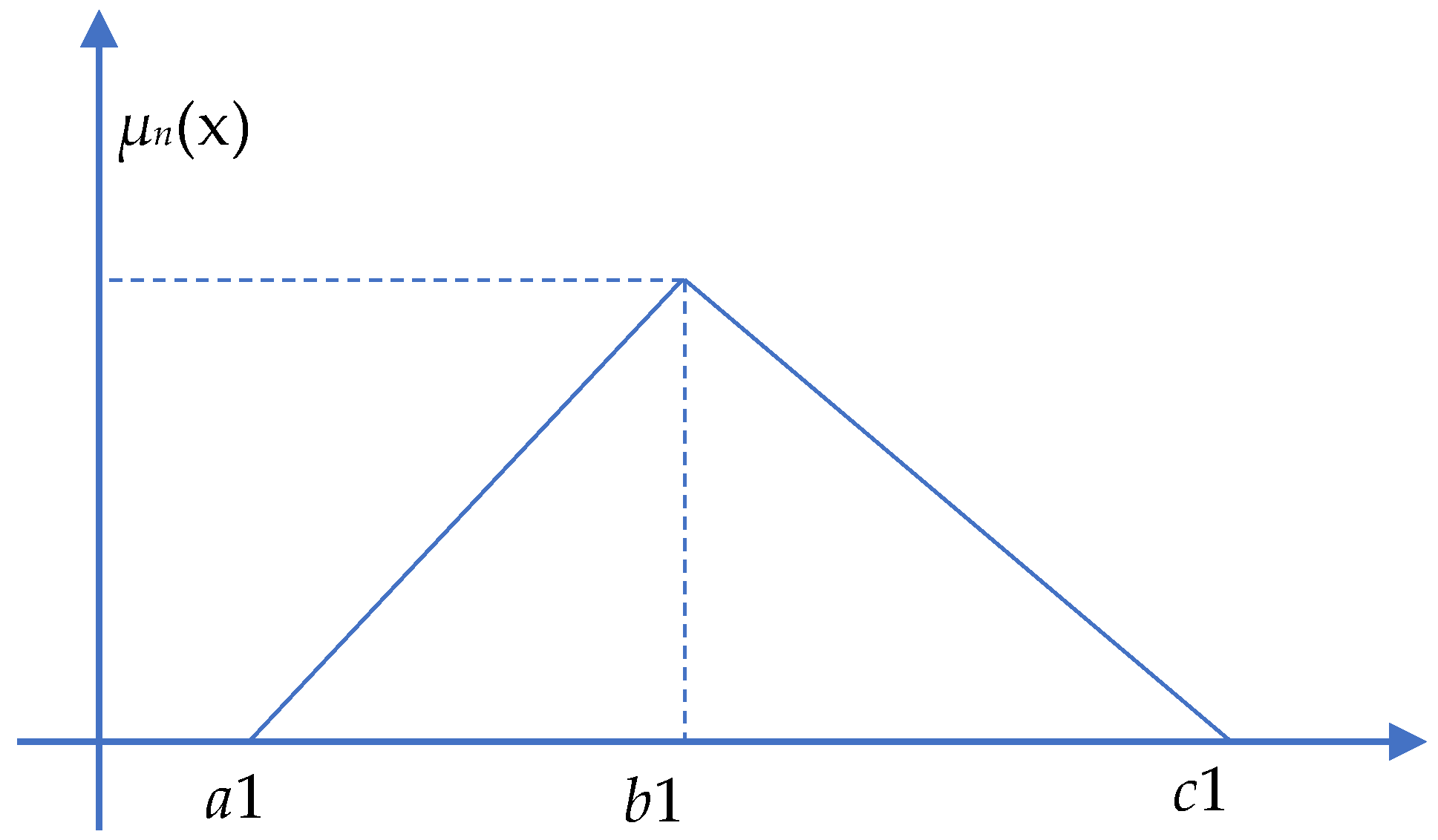
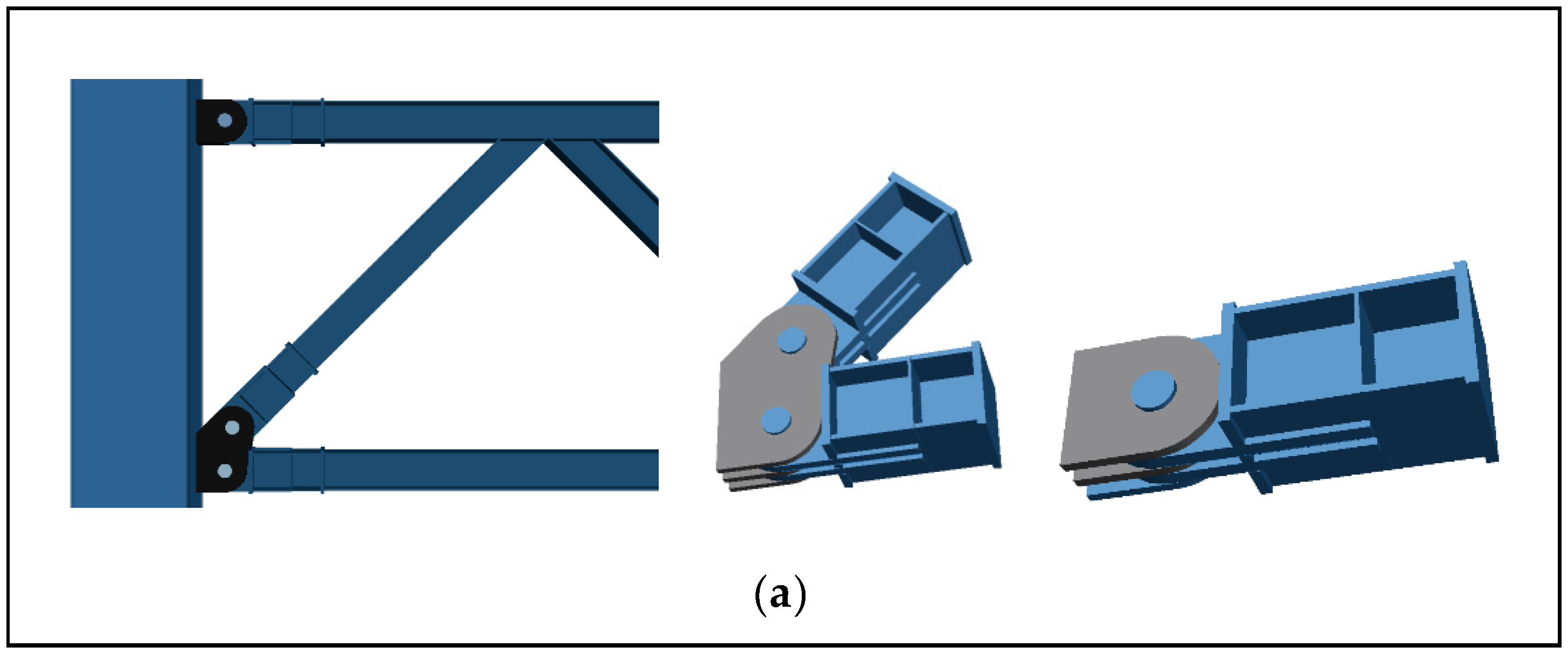
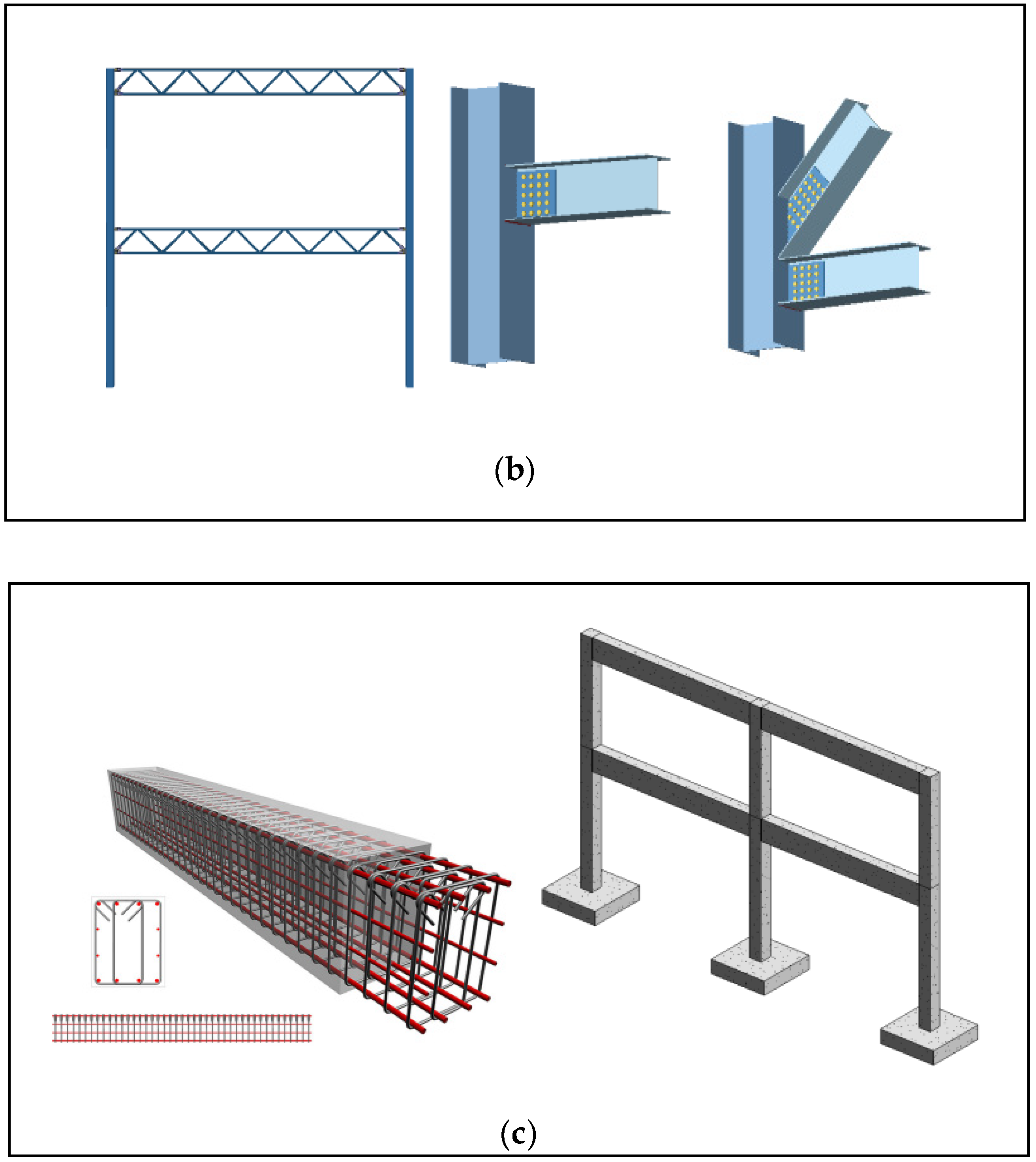

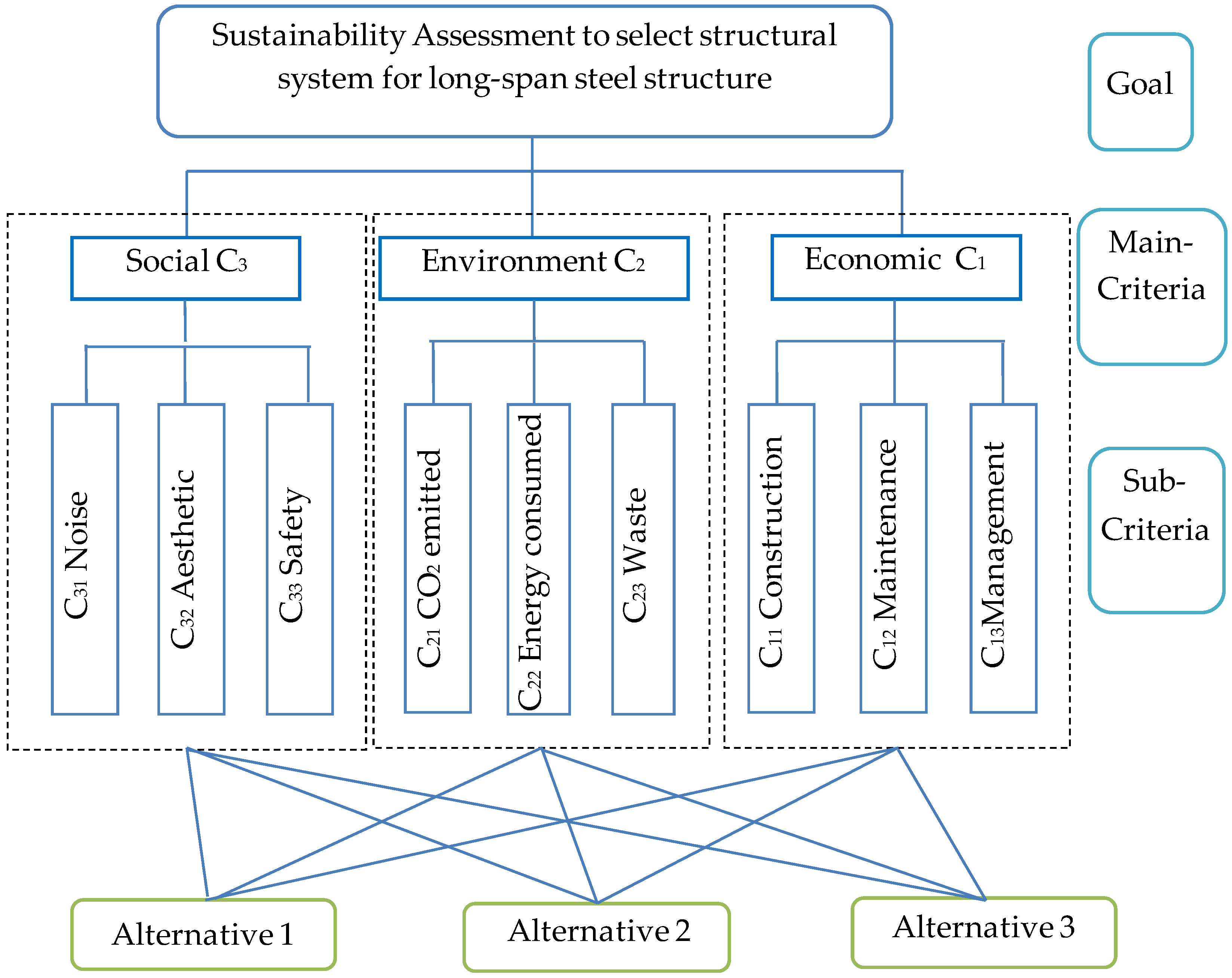
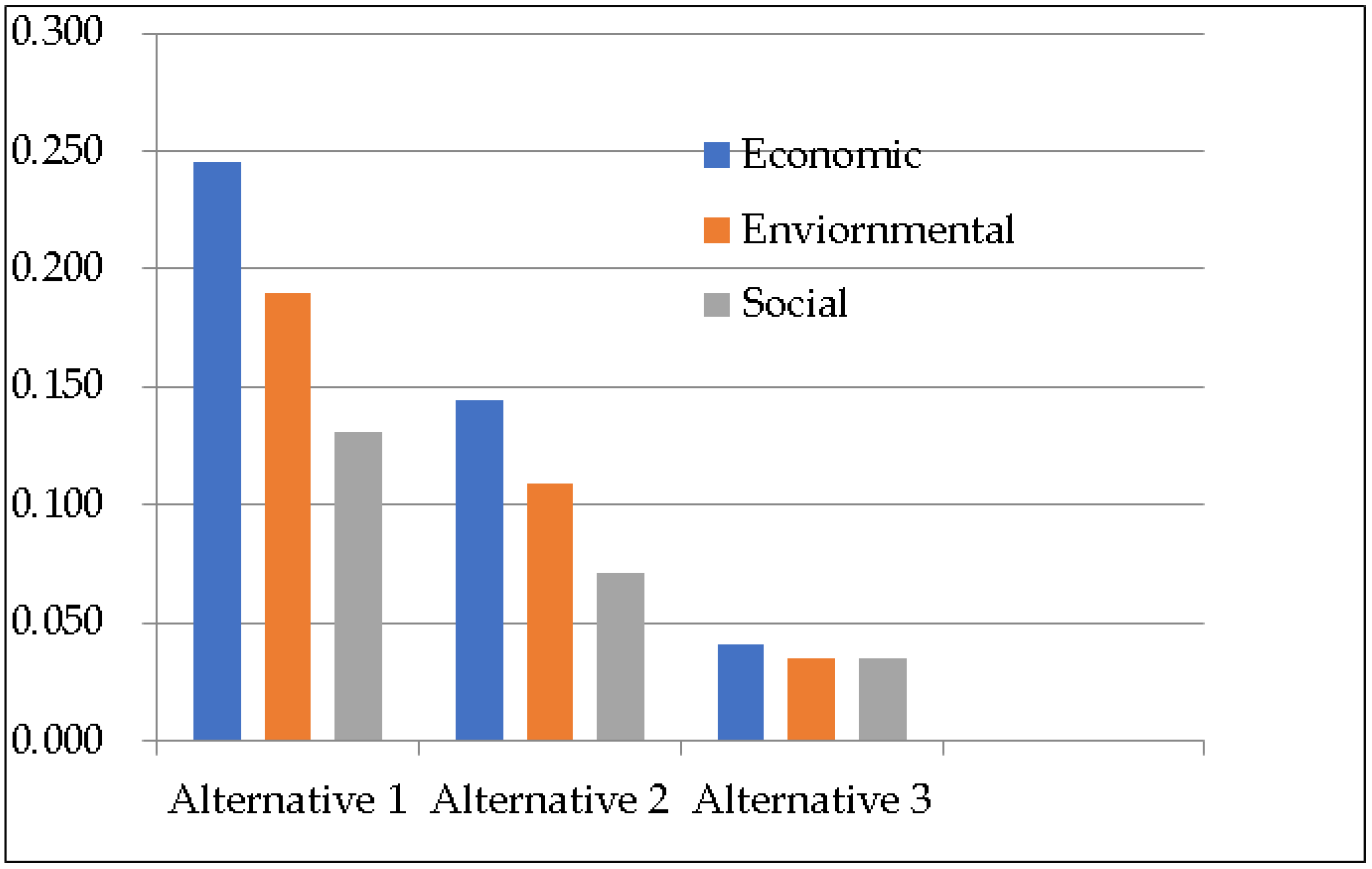


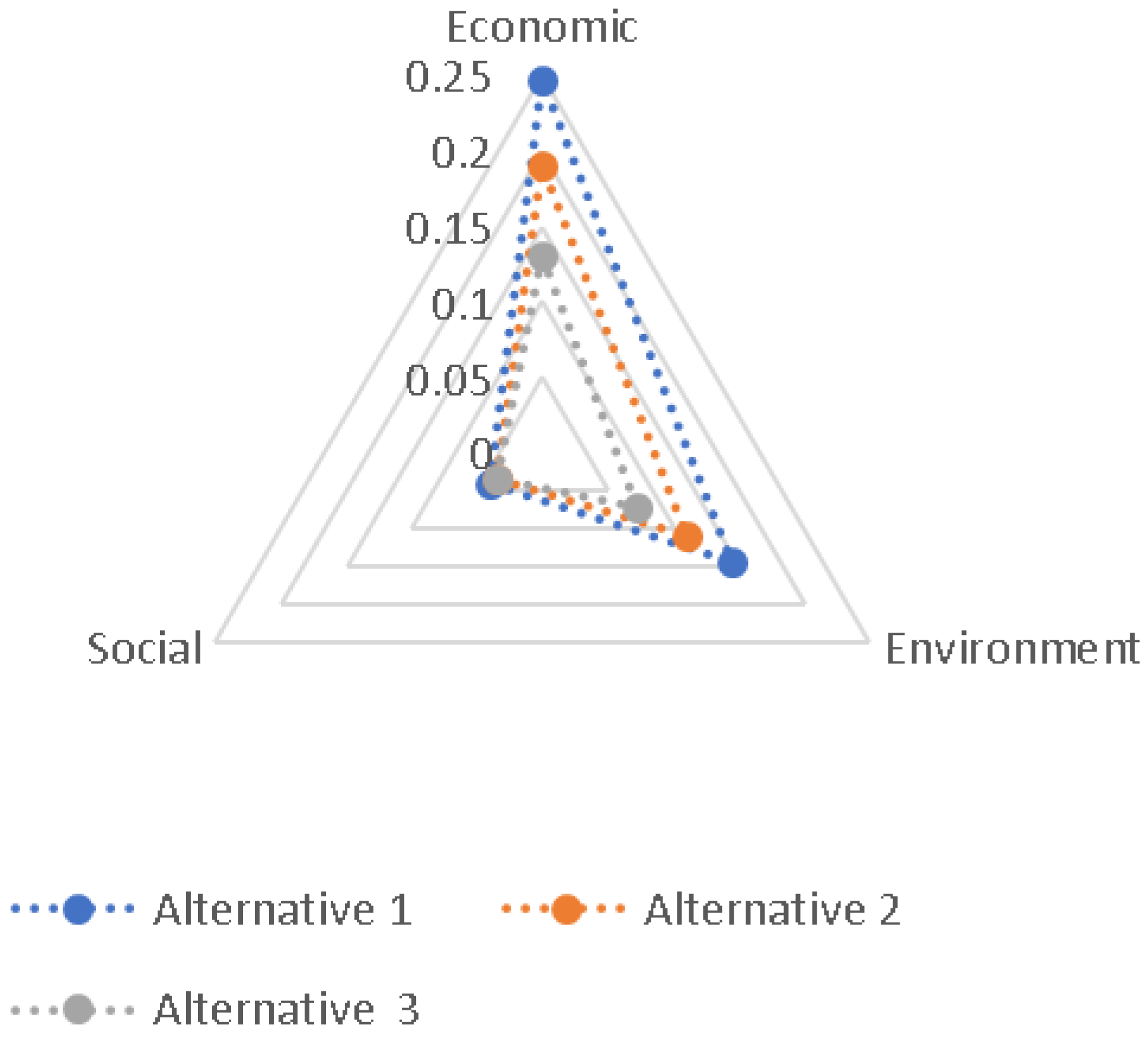
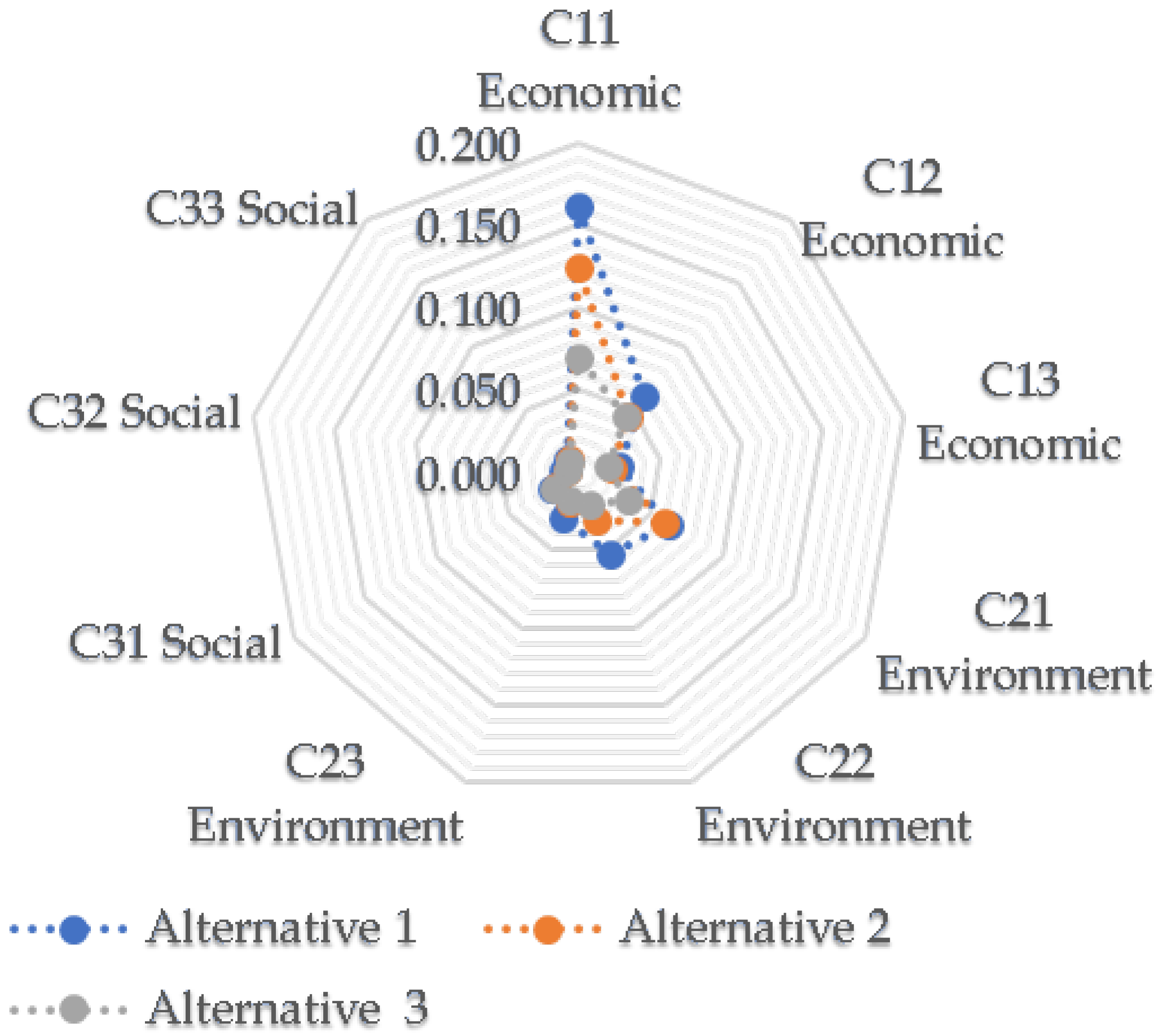
| Indicators | Criteria | Source | Main Contributions |
|---|---|---|---|
| Economic | Construction Maintenance Management Investment cost Maintenance and operation Materials cost Energy cost Risk management Life cycle impacts Design changes Constructability | [14,20,26,27] | Financial advantages of designing flexible spaces that can be easily adapted to future needs, extending the building’s useful life. Designing structures with reused components; the use of eco-friendly, recycled, and locally sourced materials to reduce environmental impact; analysis of the cost differences between conventional and sustainable materials and the long-term benefits; life cycle assessment methods; and assessing the sustainability of alternative structural solutions. |
| Environment | CO2 emissions Energy consumption Waste Recycling and reuse Noise Dust and air pollution Resources, consumption, water, land, and materials Production Transportation Waste management | [28,29,30,31,32] | Site selection and materials to energy efficiency and waste management; sustainable material selection with hybrid MCDA; environmental enhancement via building refurbishment; green building indicators; using materials with low environmental impact; engaging all stakeholders early in the design process to identify and implement sustainable solutions; and incorporating new technologies and approaches. |
| Social | Noise Aesthetic Safety Health Comfort Functions Reliability/maturity Design life Efficiency Primary energy ratio | [17,22,26,33,34,35] | Promote well-being, equity, and community engagement; project site selection based on health and well-being; social aspect implementation in sustainable construction; social effects by construction methods; ensuring buildings are structurally sound; engaging the community and stakeholders in the planning and design process; and spaces that support community resilience. |
| Others | Resource Technology Strategic (political) culture Energy Performance Engineering resource Project management Regulatory | [26,36,37,38,39,40] | Novel sustainability framework; sustainable MCDA in civil engineering through technology, culture, and polices; incorporating advanced building management systems; aligning building projects with government policies and initiatives; involving architects, engineers, policymakers, and other stakeholders from the outset; and adopting a mindset of continuous improvement. |
| Method | Advantage | Limitation | Recommendation |
|---|---|---|---|
| AIRM Aggregated Indices Randomization Method | Ordinal non-numerical information can be translated into a framework. | Time-related biases, especially as sample sizes grow. | Analysis with non-numeric (ordinal), imprecise (interval), and incomplete expert insights. |
| AHP Analytic Hierarchy Process | Deliberate inclusion of both qualitative and quantitative elements. | This process entails defining the decision problem with precision and crafting accurate pairwise comparison matrices. | Well suited for crafting decisions that encompass a multitude of stakeholders and diverse criteria. |
| ANP Analytic Network Process | This approach tackles intricate decision challenges involving interconnected criteria and alternatives. | It is more intricate and time intensive compared to the AHP, demanding both expertise and comprehensive data input. | However, it excels in guiding construction decisions where interdependencies among criteria and alternatives are significant. |
| ARM/ARAS Additive Ratio Assessment Method | Effective for quantitative measurements and allows for flexible adjustment of weights and preference values. | Lacks efficacy in qualitative initial assessments and comparative preference analysis. | It finds extensive use in solving various problems across diverse domains, such as supplier selection and construction issues. |
| BWM Best Worst Method | Straightforward and user friendly for pinpointing critical factors. | Overlooks interactions between criteria or alternatives. | Conducting pairwise comparisons to ascertain the optimal and least favorable elements within each criterion. |
| COPRAS Complex Proportional Assessment | Assuming independence between positive and negative ratios. | Subjectivity is involved in assigning weights to criteria. | Particularly useful for structured evaluation processes in construction decisions. |
| DEMATEL Decision-making Trial and Evaluation Laboratory | Examines the causal connections between criteria and pinpoints pivotal factors. | It prioritizes understanding relationships. | This approach suits decision making in construction, where grasping causal links is vital. |
| ELECTRE Elimination and Choice Expressing Reality | Tackles the challenge of reconciling diverse criteria through a clear evaluation process. | It takes into account preferences and their respective weights, requiring substantial data. | It is used for construction decisions characterized by conflicting criteria and a is requirement for transparency. |
| Fuzzy AHP Fuzzy TOPSIS Fuzzy FMEA and Fuzzy VIKOR | Triangular fuzzy numbers capture the inherent subjectivity of human opinions, while the entropy weighting method efficiently reflects the actual dynamics of decision-making, contingent upon the chosen evaluation criteria. | This method accounts for a decision maker’s inclination to allow a single attribute of a candidate or organization to disproportionately influence their overall assessment. | A fuzzy set is well suited for scenarios where precise boundaries or categories are difficult to define, and instead, there exists a degree of ambiguity or uncertainty. |
| GTA Graph-Theoretic Analysis | Their simplicity and versatility make them applicable across diverse fields. | The permanent function employs qualitative values for different terms. | Widely employed to depict nearly any physical scenario comprising discrete objects and their relationships. |
| GRA Gray Relational Analysis | This method evaluates the connection between input and output variables. | It is influenced by the choice of reference series and can be challenging to determine input variable weights. | It is valuable for understanding how input variables impact outcomes in construction. |
| LINMAP Linear Programming Techniques for Multidimensional Analysis of Preference | The LINMAP procedure does not require the decision maker to provide all paired comparison judgments. | However, it is difficult to assess partial orders and obtain reliable weights. | Environmental management, distribution, hydrology, finance, chemistry, logistics, energy management, healthcare, manufacturing, sports, etc. |
| MAUT Multi-Attribute Utility Theory | MAUT allows decision makers to consider multiple attributes simultaneously. | MAUT can be complex and time consuming. | Involve stakeholders in the decision-making process to ensure that their preferences and concerns are adequately represented. |
| MIVES Integrated Value Model for Sustainability Assessment | MIVES considers multiple dimensions of sustainability. | Relies on data for various indicators, potentially leading to biases or disagreements. | Transparency and stakeholder engagement. |
| MOORA Multi-objective Optimization by Ratio Analysis | It can utilize this approach easily to assess different options and choices. | Predicting the weights assigned to different criteria can be challenging. | Performance evaluation in the real estate sector, contractor selection, design selection, and robot selection. |
| Integrated Methods (Integrated DEMATEL-ANP, Fuzzy FMEA and VIKOR, Gray AHP, Gray TOPSIS, etc.) | It helps alleviate concerns, like human bias and judgment ambiguity. | However, challenges persist in modeling discrete data, particularly when information is lacking, leading to varied outcomes. | In complex projects, it becomes crucial to compare the results generated by diverse methodologies to develop a comprehensive index. |
| PROMETHEE Preference Ranking Organization Method for Enrichment Evaluations | Ranking alternatives involves comparing them pairwise, taking into account preferences and indifference. | Rankings are more sensitive to normalization methods and weights. | This method is applicable for construction decisions with clearly defined preferences and pairwise comparisons. |
| SAW/WSM Simple Additive Weightage/Weighted sum method | A proportional linear transformation of raw data. | However, it can be influenced by self-assessment bias. | It is particularly favored for less complex problem environments due to its simplicity. |
| SWARA Stepwise Weight Assessment RatioAnalysis | This approach establishes priorities based on firms’ or nations’ set policies and strategies. | Relying on a single ratio might lack comprehensive information and could potentially mislead regarding profits. | It is regarded as the most effective method for evaluating criteria, particularly for determining their relative weights. |
| TOPSIS Technique for Order Preference by Similarity to Ideal Solution | Identifies alternatives that closely approximate the ideal solution and accommodates nonlinear relationships. | Rankings are notably influenced by the weights. | It involves defining criteria, standardizing data, and computing Euclidean distances to gauge the proximity of alternatives to the ideal solution, streamlining the ranking process systematically. |
| VIKOR VIseKriterijumska Optimizacija I Kompromisno Resenje | Offers a compromise solution when faced with conflicting criteria. | Rankings are affected by the weights assigned to criteria and may not be universally applicable. | Particularly beneficial for construction decisions entailing conflicting criteria and a necessity for compromise. |
| WASPAS Weighted Aggregated Sum Product Assessment | Addressing single-dimensional issues, adept at balancing multiple criteria, and easily understood. | However, it may not always accurately portray real-world scenarios, leading to illogical outcomes. | To overcome this limitation, complex alternative decisions are ranked, and optimal solutions are sought based on multiple, often conflicting criteria. |
| Importance Assessment | Fuzzy AHP Value | AHP Value |
|---|---|---|
| Absolutely strong (AS) | (8,9,9) | 9 |
| Very strong (VS) | (6,7,8) | 7 |
| Fairly strong (FS) | (4,5,6) | 5 |
| Slightly strong (SS) | (2,3,4) | 3 |
| Equal (E) | (1,1,1) | 1 |
| Slightly weak (SW) | (1/4,1/3,1/2) | 1/3 |
| Fairly weak (FW) | (1/6,1/5,1/4) | 1/5 |
| Very weak (VW) | (1/8,1/7,1/6) | 1/7 |
| Absolutely weak (AW) | (1/9,1/9,1/8) | 1/9 |
| Matrix Order | 1 | 2 | 3 | 4 | 5 | 6 | 7 | 8 |
| RI | 0.00 | 0.00 | 0.58 | 0.90 | 1.12 | 1.24 | 1.32 | 1.41 |
| Matrix Order | 9 | 10 | 11 | 12 | 13 | 14 | 15 | 16 |
| RI | 1.45 | 1.49 | 1.51 | 1.48 | 1.56 | 1.57 | 1.59 | 1.60 |
| Expert Groups | Experts | Education | Position | Justification for Expert Selection |
|---|---|---|---|---|
| Group 1 | 1 | PhD | Lecturer | Expert in structural design and construction, extensive knowledge of evaluating Criterion C1 and C2. |
| 2 | Masters | Structural engineer | Professionals in structural design who provide insights into environmental impact; essential for assessing criterion C1/C2/C3. | |
| 3 | Bachelors | Building estimator | Professionals in cost estimation for Criterion C1. | |
| 4 | TAFE/ University | Builder or supplier | Professionals in construction management; essential for assessing Criterion C1/C3. | |
| Group 2 | 5 | PhD | Prof. | Background in building design and construction and provides critical insights for Criterion C1/C2/C3. |
| 6 | PhD | Assoc. Prof. Dr. | Background in building design and construction and provides critical insights for Criterion C1/C2/C3. | |
| 7 | Masters | Structural engineer | Extensive experience in structural design is essential for evaluating Criterion C1/C2/C3. | |
| 8 | TAFE/ University | Builder or supplier | Background in building construction and materials. | |
| Group 3 | 9 | Masters | Structural engineer | Professionals in design. Essential for assessing Criterion C1. |
| 10 | Masters | Manager | Professionals from construction management; essential for assessing Criterion C1/C2/C3. | |
| 11 | Bachelors | Architect | Professionals in architectural design and green building experts. Essential for assessing Criterion C1/C2/C3. | |
| 12 | Bachelors | Building officer | Background in building construction and policy; provides critical insights for C1/C2/C3. |
| Matrix in expert terms | |||
| Experts | G1 | G2 | G3 |
| G1 | - | E | E |
| G2 | - | E | |
| G3 | - | ||
| Matrix in fuzzy terms | |||
| G | G1 | G2 | G3 |
| G1 | 1 | (1, 1, 1) | (1, 1, 1) |
| G2 | (1, 1, 1) | 1 | (1, 1, 1) |
| G3 | (1, 1, 1) | (1, 1, 1) | 1 |
| Note: The weight vector is calculated as WG = (0.333, 0.333, 0.333) | |||
| Sustainability | Matrix in expert terms | ||
| Assessment | C1 | C2 | C3 |
| C1 | - | E/SS | FS |
| C2 | - | SS | |
| C3 | - | ||
| Matrix in fuzzy terms | |||
| C1 | C1 | C2 | C3 |
| C1 | 1 | (1, 2, 3) | (4, 5, 6) |
| C2 | (1/3, 1/2, 1) | 1 | (2, 3, 4) |
| C3 | (1/6, 1/5, 1/4) | (1/4, 1/3, 1/2) | 1 |
| Note: The weight vector is calculated as WC = (0.566, 0.324, 0.110) | |||
| Matrix in expert terms | |||
| C1 | C11 | C12 | C13 |
| C11 | - | SS | FS |
| C12 | - | SS | |
| C13 | - | ||
| Matrix in fuzzy terms | |||
| C1 | C11 | C12 | C13 |
| C11 | 1 | (2, 3, 4) | (4, 5, 6) |
| C12 | (1/4, 1/3, 1/2) | 1 | (2, 3, 4) |
| C13 | (1/6, 1/5, 1/4) | (1/4, 1/3, 1/2) | 1 |
| Note: The weight vector is calculated as WC1 = (0.629, 0.264, 0.107) | |||
| Matrix in expert terms | |||
| C2 | C21 | C22 | C23 |
| C21 | - | E/SS | SS |
| C22 | - | E/SS | |
| C23 | - | ||
| Matrix in fuzzy terms | |||
| C2 | C21 | C22 | C23 |
| C21 | 1 | (1, 1, 2) | (2, 3, 4) |
| C22 | (1/2, 1, 1) | 1 | (1, 1, 2) |
| C23 | (1/4, 1/3, 1/2) | (1/2, 1, 1) | 1 |
| Note: The weight vector is calculated as WC2 = (0.483, 0.313, 0.203) | |||
| Matrix in expert terms | |||
| C3 | C31 | C32 | C33 |
| C31 | - | SS | E/SS |
| C32 | - | E/SS | |
| C33 | - | ||
| Matrix in fuzzy terms | |||
| C3 | C31 | C32 | C33 |
| C31 | 1 | (2, 3, 4) | (1, 1, 2) |
| C32 | (1/4, 1/3, 1/2) | 1 | (1, 1, 2) |
| C33 | (1/2, 1, 1) | (1/2, 1, 1) | 1 |
| Note: The weight vector is calculated as WC3 = (0.488, 0.241, 0.271) | |||
| Alternatives | Matrix in expert terms | ||
| A | A1 | A2 | A3 |
| A1 | - | E/SS | E/SS |
| A2 | - | E/SS | |
| A3 | - | ||
| Matrix in fuzzy terms | |||
| A | A1 | A2 | A3 |
| A1 | 1 | (1, 2, 2) | (1, 2, 3) |
| A2 | (1/2, 1/2, 1) | 1 | (2, 2, 3) |
| A3 | (1/3, 1/2, 1) | (1/3, 1/2, 1/2) | 1 |
| Note: The weight vector is calculated as WC = (0.454, 0.351, 0.195) | |||
| Expert Groups | Main Criteria | Sub- Criteria | A1 | A2 | A3 |
|---|---|---|---|---|---|
| G1 G2 G3 | C1: Economic (0.566) | C11 | 0.454 | 0.351 | 0.195 |
| C12 | 0.403 | 0.302 | 0.295 | ||
| C13 | 0.391 | 0.322 | 0.287 | ||
| C2: Environment (0.324) | C21 | 0.401 | 0.382 | 0.217 | |
| C22 | 0.522 | 0.302 | 0.196 | ||
| C23 | 0.446 | 0.287 | 0.267 | ||
| C3: Social (0.110) | C31 | 0.359 | 0.311 | 0.330 | |
| C32 | 0.397 | 0.301 | 0.302 | ||
| C33 | 0.356 | 0.335 | 0.309 |
| Experts | Main Criteria | Sub-Criteria | Local Weight | Global Weight | Rank | |
|---|---|---|---|---|---|---|
| Multi-criteria analysis results | G1 G2 G3 | C1: Economic (0.566) | C11 | 0.629 | 0.356 | 1 |
| C12 | 0.264 | 0.149 | 3 | |||
| C13 | 0.107 | 0.061 | 6 | |||
| C2: Environment (0.324) | C21 | 0.483 | 0.156 | 2 | ||
| C22 | 0.313 | 0.101 | 4 | |||
| C23 | 0.203 | 0.066 | 5 | |||
| C3: Social (0.110) | C31 | 0.488 | 0.054 | 7 | ||
| C32 | 0.241 | 0.027 | 9 | |||
| C33 | 0.271 | 0.030 | 8 |
| Sub-Criteria | Global Weight | A1 | A2 | A3 |
|---|---|---|---|---|
| C11 | 0.356 | 0.162 | 0.125 | 0.069 |
| C12 | 0.149 | 0.060 | 0.045 | 0.044 |
| C13 | 0.061 | 0.024 | 0.020 | 0.018 |
| C1 Total | 0.566 | 0.246 | 0.190 | 0.131 |
| C21 | 0.156 | 0.063 | 0.060 | 0.034 |
| C22 | 0.101 | 0.053 | 0.031 | 0.020 |
| C23 | 0.066 | 0.029 | 0.019 | 0.018 |
| C2 Total | 0.323 | 0.145 | 0.109 | 0.071 |
| C31 | 0.054 | 0.019 | 0.017 | 0.018 |
| C32 | 0.027 | 0.011 | 0.008 | 0.008 |
| C33 | 0.030 | 0.011 | 0.010 | 0.009 |
| C3 Total | 0.111 | 0.041 | 0.035 | 0.035 |
| Total | 1.000 | 0.431 | 0.333 | 0.236 |
| Ranking | N/A | 1 | 2 | 3 |
| Indicator | Criteria | Global Weights | Ranking | ||
|---|---|---|---|---|---|
| A1 | A2 | A3 | |||
| 1 | Economic | 0.246 | 0.190 | 0.131 | A1 > A2 > A3 |
| 2 | Environment | 0.145 | 0.109 | 0.071 | A1 > A2 > A3 |
| 3 | Social | 0.041 | 0.035 | 0.035 | A1 > A2 = A3 |
Disclaimer/Publisher’s Note: The statements, opinions and data contained in all publications are solely those of the individual author(s) and contributor(s) and not of MDPI and/or the editor(s). MDPI and/or the editor(s) disclaim responsibility for any injury to people or property resulting from any ideas, methods, instructions or products referred to in the content. |
© 2024 by the authors. Licensee MDPI, Basel, Switzerland. This article is an open access article distributed under the terms and conditions of the Creative Commons Attribution (CC BY) license (https://creativecommons.org/licenses/by/4.0/).
Share and Cite
Ma, J.; Siddhpura, M.; Haddad, A.; Evangelista, A.; Siddhpura, A. A Multi-Criteria Decision-Making Approach for Assessing the Sustainability of an Innovative Pin-Connected Structural System. Buildings 2024, 14, 2221. https://doi.org/10.3390/buildings14072221
Ma J, Siddhpura M, Haddad A, Evangelista A, Siddhpura A. A Multi-Criteria Decision-Making Approach for Assessing the Sustainability of an Innovative Pin-Connected Structural System. Buildings. 2024; 14(7):2221. https://doi.org/10.3390/buildings14072221
Chicago/Turabian StyleMa, Jianwei, Milind Siddhpura, Assed Haddad, Ana Evangelista, and Arti Siddhpura. 2024. "A Multi-Criteria Decision-Making Approach for Assessing the Sustainability of an Innovative Pin-Connected Structural System" Buildings 14, no. 7: 2221. https://doi.org/10.3390/buildings14072221
APA StyleMa, J., Siddhpura, M., Haddad, A., Evangelista, A., & Siddhpura, A. (2024). A Multi-Criteria Decision-Making Approach for Assessing the Sustainability of an Innovative Pin-Connected Structural System. Buildings, 14(7), 2221. https://doi.org/10.3390/buildings14072221











